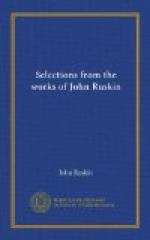In all my past work, my endeavour has been to show that good architecture is essentially religious—the production of a faithful and virtuous, not of an infidel and corrupted people. But in the course of doing this, I have had also to show that good architecture is not ecclesiastical. People are so apt to look upon religion as the business of the clergy, not their own, that the moment they hear of anything depending on “religion,” they think it must also have depended on the priesthood; and I have had to take what place was to be occupied between these two errors, and fight both, often with seeming contradiction. Good architecture is the work of good and believing men; therefore, you say, at least some people say, “Good architecture must essentially have been the work of the clergy, not of the laity.” No—a thousand times no; good architecture[211] has always been the work of the commonalty, not of the clergy. “What,” you say, “those glorious cathedrals—the pride of Europe—did their builders not form Gothic architecture?” No; they corrupted Gothic architecture. Gothic was formed in the baron’s castle, and the burgher’s street. It was formed by the thoughts, and hands, and powers of labouring citizens and warrior kings. By the monk it was used as an instrument for the aid of his superstition; when that superstition became a beautiful madness, and the best hearts of Europe vainly dreamed and pined in the cloister, and vainly raged and perished in the crusade,—through that fury of perverted faith and wasted war, the Gothic rose also to its loveliest, most fantastic, and, finally, most foolish dreams; and in those dreams, was lost.
I hope, now, that there is no risk of your misunderstanding me when I come to the gist of what I want to say to-night;—when I repeat, that every great national architecture has been the result and exponent of a great national religion. You can’t have bits of it here, bits there—you must have it everywhere or nowhere. It is not the monopoly of a clerical company—it is not the exponent of a theological dogma—it is not the hieroglyphic writing of an initiated priesthood; it is the manly language of a people inspired by resolute and common purpose, and rendering resolute and common fidelity to the legible laws of an undoubted God.




